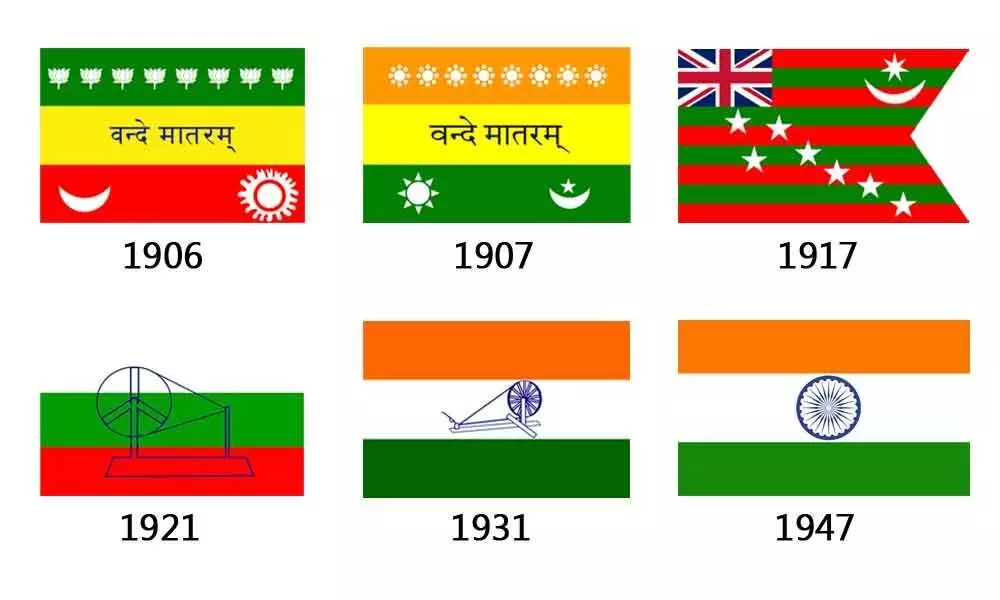Live
- WHAT HMPV INCIDENCE TELLS US
- MyVoice: Views of our readers 13thJanuary 2025
- TIME FOR OVERHAUL OF TOP BRASS OF TTD
- Deputy CM Bhatti Vikramarka promises comprehensive development of Palamuru dist
- Rich tributes paid to Swami Vivekananda
- Indiramma model unit ready for opening
- Advocate Prasuna new DLSA member
- MLA Yennam unveils Hans india calendar
- Rythu Bharosa soon after Sankranti festival says Uttam Kumar Reddy
- PURE EV expands footprint in state
Just In
History Of Tiranga - The Evolution of Indian Tricolor


A flag is a necessity for all nations. Millions have died for it. It is no doubt a kind of idolatry which would be a sin to destroy.
"A flag is a necessity for all nations. Millions have died for it. It is no doubt a kind of idolatry which would be a sin to destroy. For, a flag represents an Ideal The unfurling of the Union Jack evokes in the English breast sentiments whose strength it is difficult to measure. The Stars and Stripes mean a world to the Americans. The Star and the Crescent will call forth the best bravery in Islam."
"It will be necessary for us Indians Muslims, Christians Jews, Parsis, and all others to whom India is their home-to recognize a common flag to live and to die for."
- Mahatma Gandhi
Each of the world's free nations has its own flag. It symbolizes a free country. During the Constituent Assembly meeting held on 22 July 1947, a few days before India's independence from the British on 15 August 1947, the National Flag of India was adopted in its present form. It served as the national flag of the Dominion of India between 15 August 1947 and 26 January 1950 and that of the Republic of India thereafter. In India, the term "tricolor" refers to the Indian national flag.
India's National Flag is horizontal deep saffron (Kesari) tricolor in the center, white in the center, and dark green at the bottom in equal proportion. The flag's width-to-length ratio is two to three. A navy blue wheel that reflects the chakra is in the middle of the white band. Its design is that of the wheel which appears on the abacus of the Sarnath Lion Capital of Ashoka. Its diameter approximates to the width of the white band and it has 24 spokes.
Evolution of the Tricolour
1) It is really amazing to see the various changes that our National Flag went through since its first inception. It was discovered or recognized during our national struggle for freedom. The evolution of the Indian National Flag sailed through many vicissitudes to arrive at what it is today. In one way it reflects the political developments in the nation. Some of the historical milestones in the evolution of our National Flag involve the following:
2) The first national flag in India is said to have been hoisted on August 7, 1906, in the Parsee Bagan Square (Green Park) in Calcutta now Kolkata. The flag was composed of three horizontal stripes of red, yellow and green.
3) Mrs. Cama and her band of exiled revolutionaries hoisted the second flag in Paris in 1907 (according to some inl9OS). This was very similar to the first flag except that the top strip had only one lotus but the Saptarishi was denoted by seven stars. The flag was also on display at a Berlin socialist conference.
4) In 1917 the third flag went up as our political struggle took a definite turn. During the Home rule campaign, Dr Annie Besant and Lokmanya Tilak hoisted it. This flag was arranged alternately with five red and four green horizontal stripes, with seven stars superimposed on them in saptarishi configuration. The Union Jack stood in the top left-hand corner (the pole end). There was also a white crescent and star in one corner.
5) During the All India Congress Committee meeting in Bezwada in 1921 (now Vijayawada), a youth from Andhra prepared a flag and carried it to Gandhiji. It consisted of two red and green colors reflecting the two main cultures, i.e. Hindus, Muslims. Gandhiji suggested the addition of a white strip to represent the remaining communities of India and the spinning wheel to symbolize the progress of the Nation.
6) The year 1931 was a landmark on the flag's history. It passed a resolution introducing a tricolor flag as our national flag. This flag, the present one's forbear, was saffron, white and green with the spinning wheel of Mahatma Gandhi in the middle. Nevertheless, it was clearly stated that it had no social significance and should be treated as such.
7) On July 22, 1947, the Constituent Assembly adopted it as Free India National Flag. After the advent of Independence, the colors and their significance remained the same. Only the Dharma Charkha of Emperor Asoka was adopted in place of the spinning wheel as the emblem on the flag. Thus, the tricolor flag of the Congress Party eventually became the tricolor flag of Independent India.

© 2025 Hyderabad Media House Limited/The Hans India. All rights reserved. Powered by hocalwire.com






